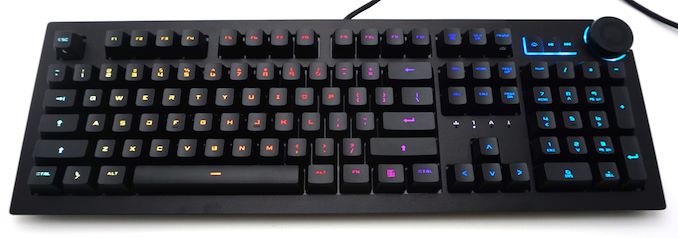The Das Keyboard 5Q Cloud-Connected Mechanical Keyboard Review: How To Get Noticed
by E. Fylladitakis on February 26, 2019 10:00 AM ESTConclusion
It is obvious that Das Keyboard tried to make the 5Q be as unique as a mechanical keyboard can be nowadays. Aside from it being the first "cloud-connected" mechanical keyboard, the company is also using proprietary mechanical switches that are exclusively available to them. The company’s point was to create a product that has no direct competition and, in a way, they have succeeded.
Generally speaking, the Das Keyboard 5Q is a very well-designed, reliable mechanical keyboard. Its design is deceptively unassuming, masking the advanced electronics and proprietary mechanical switches hidden inside the simple but elegant chassis. In terms of quality, we cannot voice even a single complaint.
The Omron-made Gamma Zulu switches left us with mixed feelings. They are very responsive, quick switches, with strong and quick recovery. These characteristics, along with the shorter travel distance, make the Gamma Zulu an excellent gaming switch. For professional use, however, the Das Keyboard 5Q is a bit more tiring than a keyboard featuring standard switches, tactile or not. Furthermore, the feeling of the Omron-made switches is mushy and the tactile feedback is hardly even noticeable. We would not go as far to say that the feeling resembles membrane-based switches but it may alienate people who were already used to other mechanical switches.
Das Keyboard’s idea of a cloud-connected keyboard certainly is innovative and, for the time being, unique to their top-tier keyboards. Although there is a learning curve for a user to be ready and take full advantage of the keyboard’s capabilities, the possibilities are virtually endless, especially for users with some API programming skills. Casual users can easily take advantage of the pre-programmed applets, which may be but a fraction of the keyboard’s full capabilities, but can be useful nonetheless.
The only problem here is that visual feedback from the keyboard is not really practical. This is especially the case when it comes to important notifications, as any notification can be easily missed if the user is not looking at the keyboard. Which due to the very nature of touch typing is usually going to be the case, and even more so for a high-end product like a Das Keyboard that's aimed at experienced typists (to say nothing of their unlabeled Ultimate boards). So while novel in application, it's not clear that visual notifications on a keyboard are going to be all that useful; at least not for time-sensitive notifications.
The utility of keyboard notifications then is a bit of a compromise: cloud-based feedback can be helpful, but probably only non-sensitive notifications, such as for weather forecasts. Conversely, I can't help but feel that a more traditional high-end keyboard that includes key programming and remapping would probbaly be much more useful for most users; professionals and gamers alike.
In summary, the Das Keyboard 5Q is an excellent quality mechanical keyboard, sporting the unique capability of connecting to the internet and taking advantage of cloud-based services. With a feature set no other keyboard can match, the 5Q stands out as a premium product for users that really want something different and/or find its cloud-based capabilities interesting. However its unique and cutting-edge features come with a $220 price tag, which is high even for a high-end keyboard. Ultimately this makes the Das Keyboard 5Q a niche product: if you like the idea of a keyboard that can provide visual notifications, then the 5Q is going to meet your needs nicely. But for typical professionals and/or gamers who aren't interested in the 5Q's niche features, a more traditional but equally-excellent keyboard can be had for a lot less.












33 Comments
View All Comments
m16 - Monday, April 5, 2021 - link
Coming back to this, this type of keyboard, if made offline-only, could just be made to have the APIs to monitor local services/hardware.There's some useful stuff in the form of color-monitoring CPU %, Memory % and GPU % which is pretty nifty.
There's also mini applets that set timers and reminders, without having to break your workflow or touch the mouse.